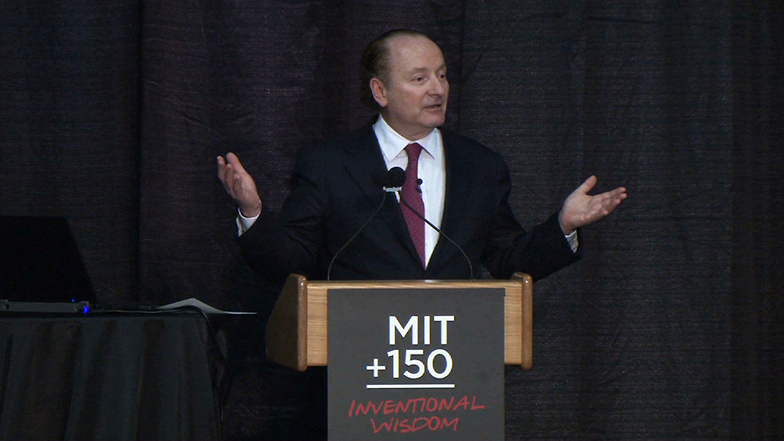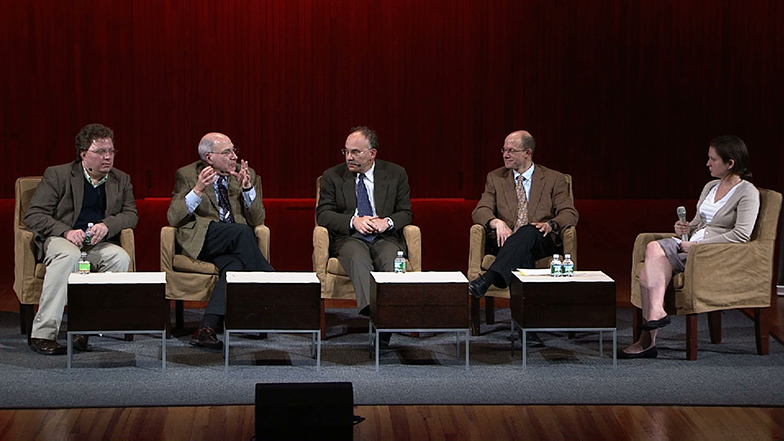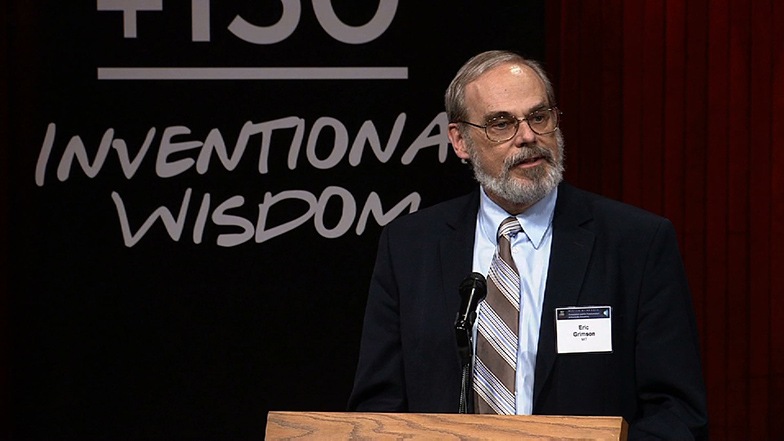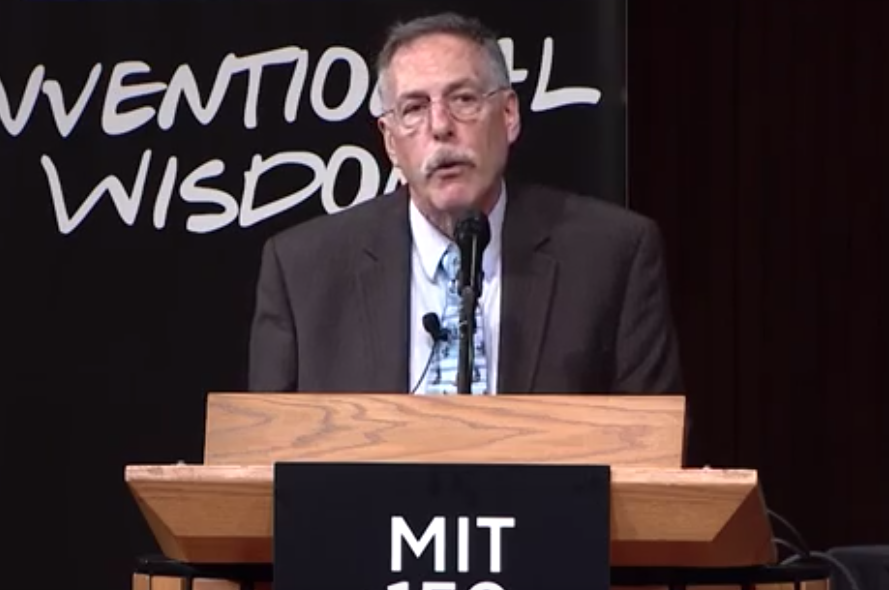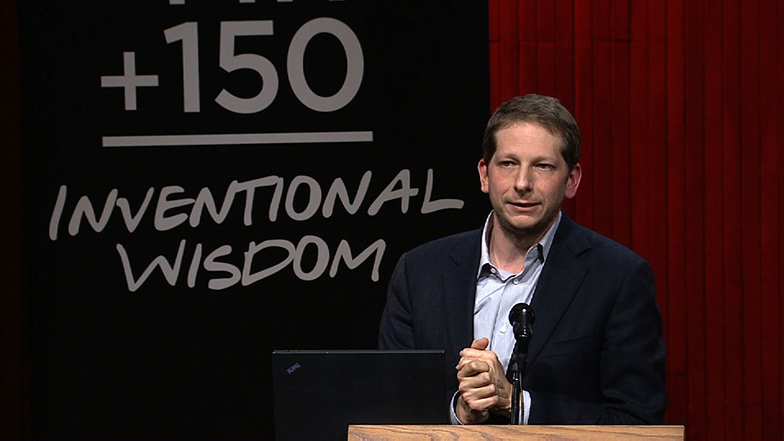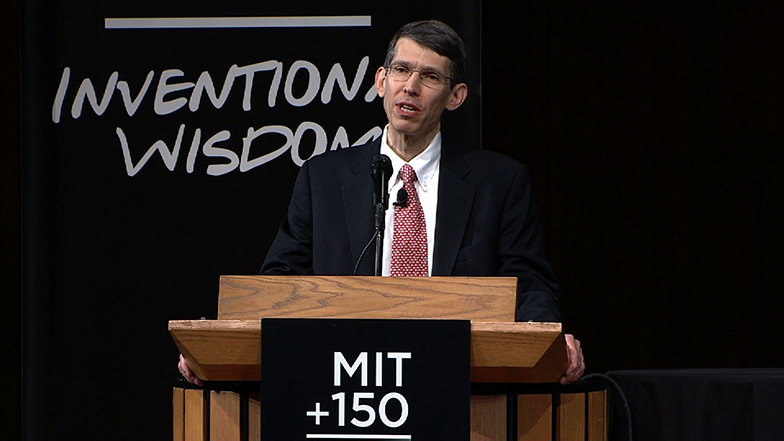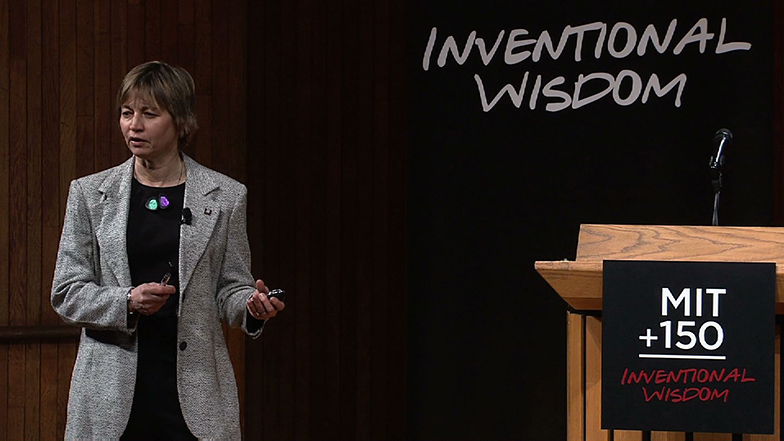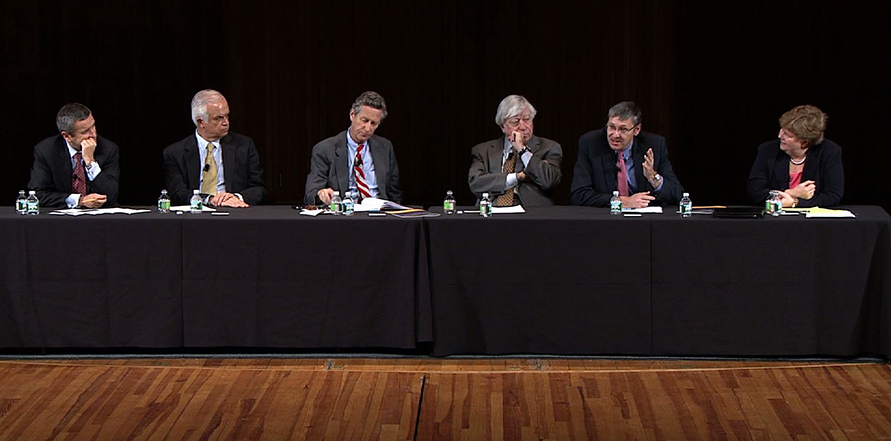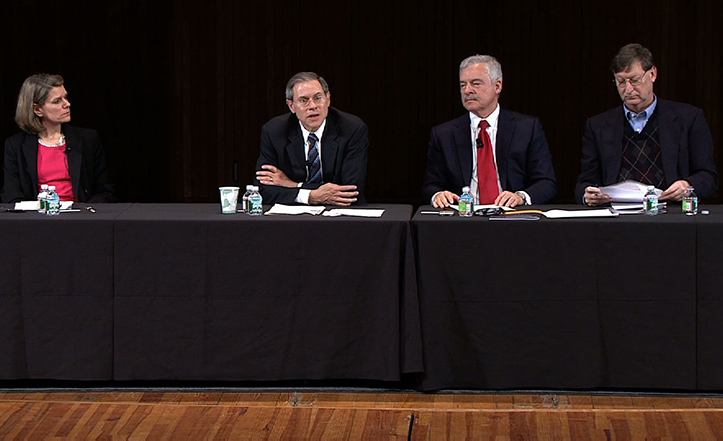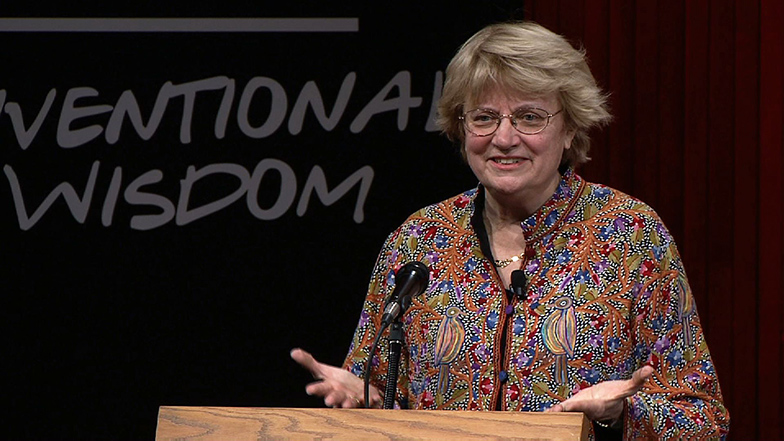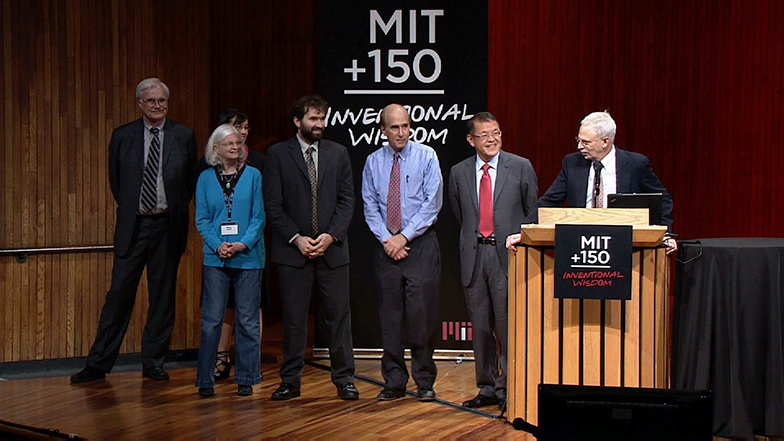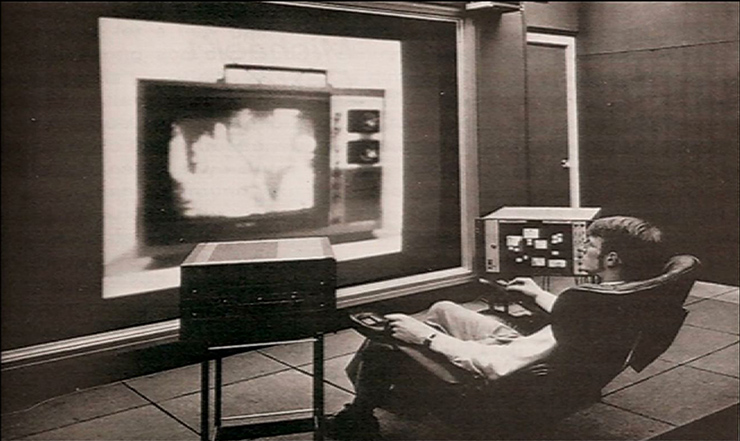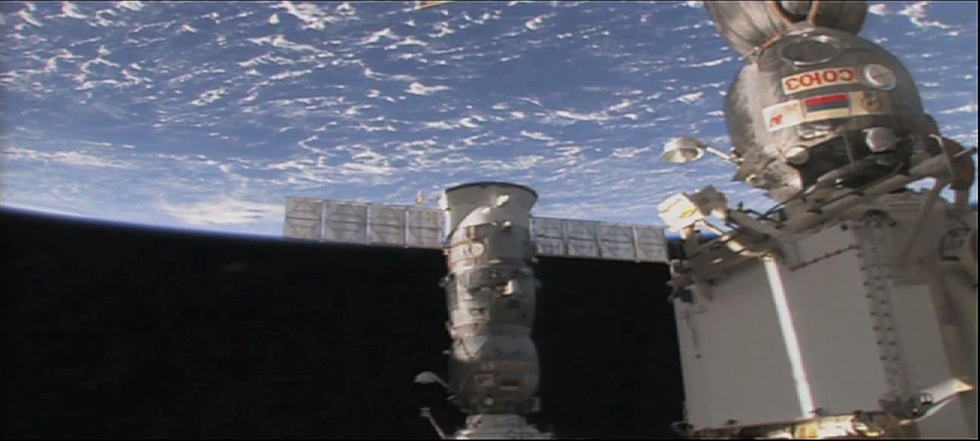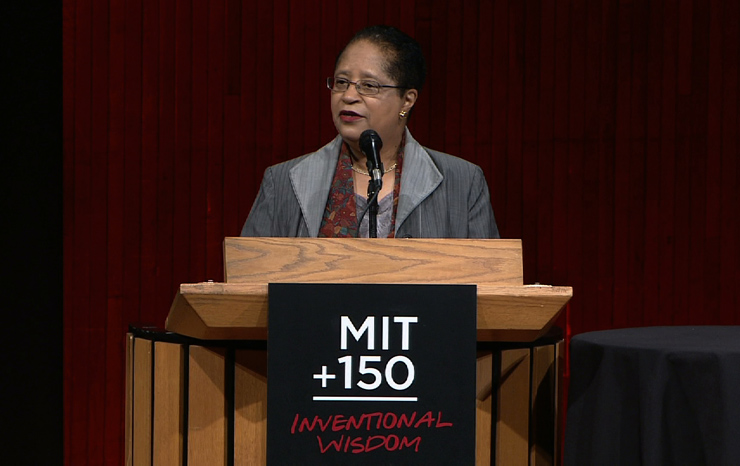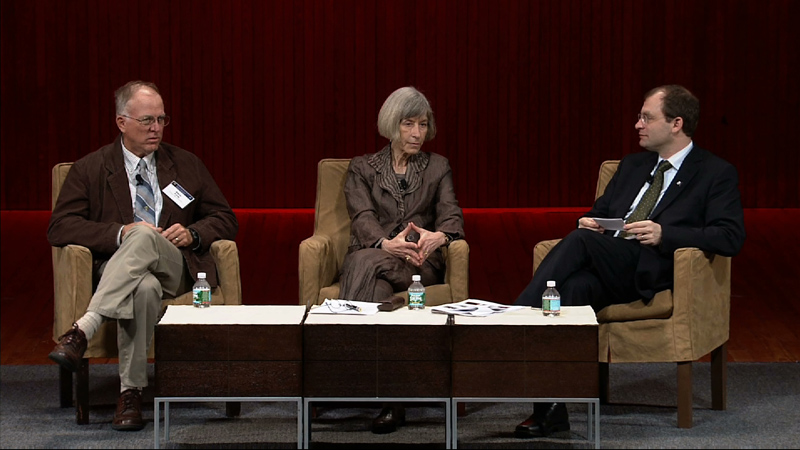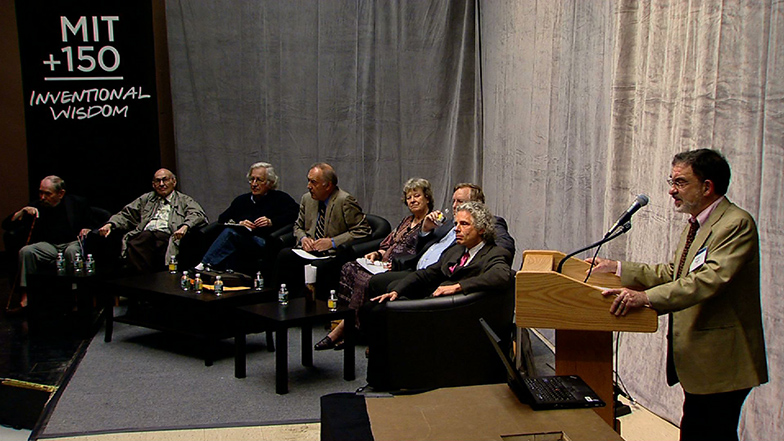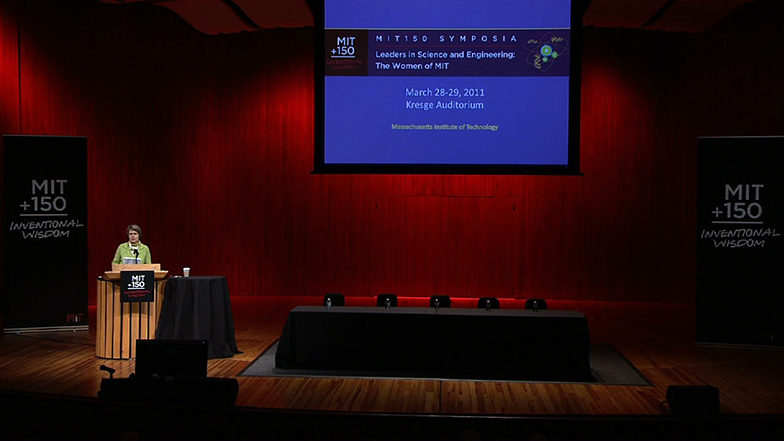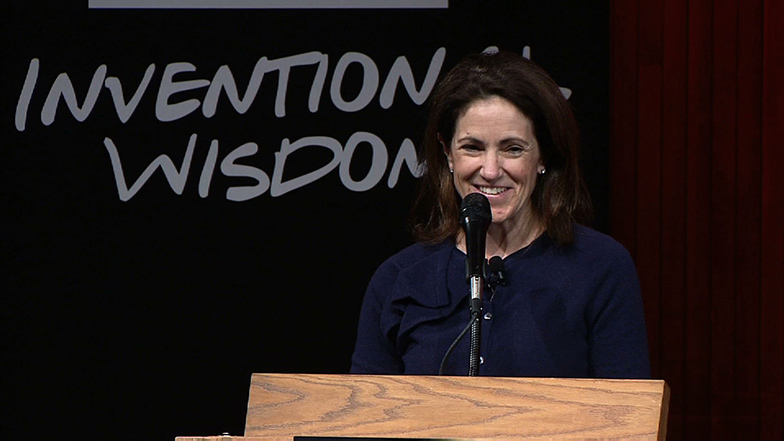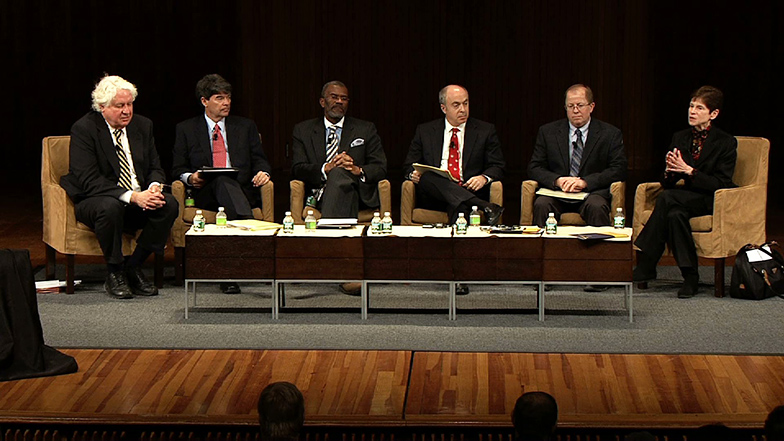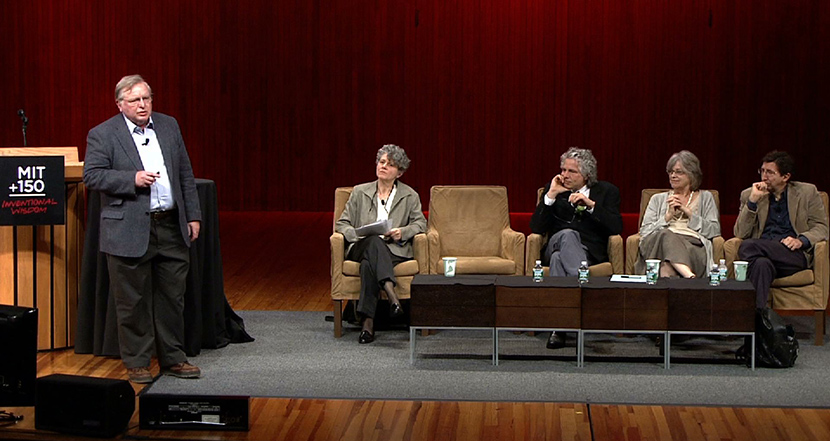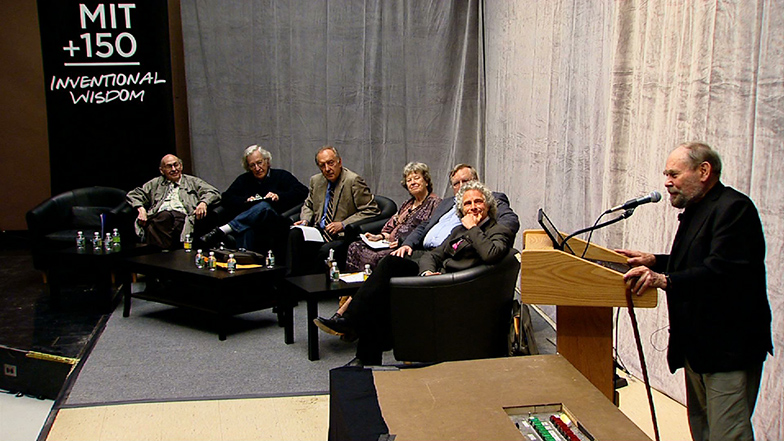Future of Exploration: Exploration Visions (Panel I)
KOBRICK: Good morning everyone and welcome to our first panel for the day. We have a panel of experts here that are going to describe their visions for the future. And I'm glad you could join us. And the people that are watching online, I'm really happy that you're also participating, and of course the future generations that'll look back on the archive and check out what we had to say during this 150th celebration.
So before I let our experts go to town here, I'm going to present a few slides on some of my thoughts on the vision of the future. So the first step, I feel that for exploration and making your way into a vision is that you really need to be inspired. And so this is one of those moments for me that I was really inspired by the X Prize Foundations' work with the Ansari X Prize. And this shot was taken in June, the first space flight of SpaceShipOne. So this was the test flight. But this is the first time they actually entered space. And it was a really exciting moment.
And so when Mike Melvill put his arms up in the air kind of a victory way, it just was like watching Rocky, but live. It was like real life. And at least he yelled yea-ha instead of slurring out something like Adrian. So that definitely helped the moment.
So the first thing is to be inspired. And the second step is to work hard. These are just some photos from some work I've done over my graduate studies out in the Arctic, and then I did some lunar dust abrasion work for my PhD. And I'd like to also think Dava Newman for having me here as a postdoc. I kind of glanced over that. But I've been here for six months. So I guess in terms of rover warranties, I've been here 180 days. So I'm worth at least two rovers.
So the big picture is that there are destinations and places that we're going to be going. But what's key is that there's a lot of steps in between. And that's sort of where this analog research that I've been involved with also fits in.
So some of the space analogs that are out there are basically trying to model your environment. So on the right of the image here we have Neemo, where there's a crew that lives underwater and simulates space operation. So both of these places are places that I'd like to go in the future. And they're kind of on my exploration bucket list.
So this is the Arctic. This is the Flashline Mars Arctic Research Station. And I spent 100 days there doing a Mars simulation. So this is one of those environments that you really learn about how to do field operations, and you really get to kind of think forward on how you're working. While we were out there, we were doing 22 different science projects. So we were slammed with work. And it really felt more like the moon when we got there because it was covered in snow.
But as the snow melted, it really started to look like Mars. And a part of that was that we were doing a lot of outreach events in conjunction with this mission. And that's really important is to inspire others to sort of complete that loop. So it's really Mars on Earth up there. It's on an impact crater. So all the science that you would do is analogous to doing science either on the Moon, or Mars, or an asteroid, just anywhere with the same kind of structure. So it was a really exciting experience. And we're glad we were able to offer more back to the community.
So to inspire others and kind of looking forward, I'm the executive director of a group called Yuri's Night. And Yuri's Night is a worldwide space celebration that sort of took the cosmic date of April 12, which is the first human spaceflight of Yuri Gagarin and the first shuttle flight, STS-1, both on April 12. And so it's a way of bringing people together to celebrate our past, present, and future in the cosmos.
So this year for Yuri's Night, it was the 50th anniversary of human space flight. So we really pumped up our numbers and we had a record breaking year with 367 events. Actually there's more like 600 events that occurred around the world. 75 countries were brought together. And one I was really excited about was the ISS.
So up on the International Space Station, we had a phone call about half a year ago from astronaut Ron Garan. And he said, can you send us some Yuri's Night shirts? And we're like sure, why not? And he ended up bringing up a pile of shirts for his crew in his personal supply gear. And astronauts have their personal supply. And it's limited. So we were really happy that we were able to link in with them. And they had a dinner and a movie night up on the space station. So that was really exciting. And they really helped to engage the public of course with their perspective.
So step four is to repeat step one, is to be inspired time and time again. Here's an image of one of our lapel pins floating free with the fragile oasis in the background. And again thanks to Ron Garan for sending that. It's great to get an email from space with the logo of the group you're working with in it. So that was really exciting. So it's really important to be inspired over and over.
So looking towards the future now for human space flight, things are going to change. We're going to be going from The Right Stuff to The Unusual Suspects. And I think that's just important that we recognize that the community's going to be different. And there's going to be different needs. And I'm looking forward to be helping with that bizarre, or maybe not so bizarre future.
So I'd like to thank you for letting me have some comments today. And so our future is into the cosmos. And I hope to be part of that with everyone.
[APPLAUSE]
So I'd like to introduce our first speaker. Anna Dietrich is the Chief Operating Officer and Acting Chief Financial Officer and Cofounder of Terrafugia And she's going to tell us all about that in her presentation. Terrafugia develops The Transition, which is a roadable light sport aircraft. Prior to founding Terrafugia she worked on the F-136 Joint Strike Fighter engine at GE Aviation in Lynn, Massachusetts, and advance combat aircraft and explorations at Boeing Phantom Works in Saint Louis, Missouri.
Terrafugia was founded in 2006 as at MIT spinoff company, and a $100K Entrepreneurship Competition runner up. Based in Woburn, Massachusetts, Terrafugia is bringing the first practical flying car to the general aviation marketplace. And without further ado, I'd like to bring up Anna. And if you'd like to see the rest of her amazing bio, I'd encourage you to check out her program. So please welcome Anna.
[APPLAUSE]
DEITRICH: Well good morning everybody. Thanks for coming out on a lovely Boston spring morning. I think most of my introduction slides were covered very expertly by Ryan. But I do want to spend just a moment celebrating the role that MIT had in creating our company since this is partly a celebration of MIT as well of exploration in general. We wouldn't be doing this at all without MIT and the people and the resources that sort of shepherded us along the way.
It was in fact on the stage that we got our runner up prize for the MIT $100K Competition. So for everyone this morning that was an honorable mention or not first place, you too can do just fine without the number one prize. So that was something that really kicked us off in terms of giving us some credibility with our business plan, as well some broader exposure. So I do you want to think MIT, their AeroAstro Department, and just the entire community for their role in getting us to where we are.
So where is that? Ryan mentioned that we're doing the first practical flying car. Certainly not a new idea, and that's one of the themes that I'll bring up again later is that exploration doesn't have to be something that's a brand new idea or a brand new place. You can reexplore things from the past. You can reexplore ideas from history and conceive of them in a new way. And to me, that's still exploration.
We're about a year away still from the first delivery of our commercial product, The Transition. I'll show some pictures of our production design. The proof of concept is actually over at Johnson. I felt a little bit like I was dropping my kid off at summer camp when we installed it there yesterday. But it's fun to have it here for the week. You'll also be able to get up close to it on Saturday at the AeroAstro open house if you're around for that as well.
So this is the production version of our Transition street legal airplane. And I'm a little bit sheepishly quoting these research results because I believe one of the people responsible for them is sharing the stage with me today. But the roadable aircraft is something that really addresses the four biggest problems associated with personal aviation. It's not just sort of a science fiction thing. It's, why do we want to do this? Well, it reduces the cost. It increases your mobility at your destination. It reduces your door to door travel time. It really improves your weather sensitivity. And overall it just makes personal aviation more convenient, more fun, and safer to boot. So that's something we can talk about more. It's obviously very close to my heart. But in the interest of getting to the themes for the morning, I'll keep moving on that one.
We also have a military program in the works right now. It's called the TX. It's for DARPA. And we're just in the conceptual design phase of it now. But you can see that basically the concept is a flying Humvee. So that's something that we hope to be able to bring some utility from our commercial program to bear for our military in the future.
So as I mentioned before, I think for me, exploration may have a little bit of a broader meaning than is traditionally construed. People can explore-- and this is something that I found with personal aviation, with people that are coming to the general aviation community, getting their pilot's license, finding out what it's like to fly their own little plane somewhere by themselves for the first time, to see an airport or a part of the country that would normally have been hidden from their daily lives because of a small plane. To me, that's really the spirit of exploration in a different sort of sense. You're not going to the moon. You're flying from Lawrence to Minuteman perhaps. But even that short flight can really give you a sense of what it's like to be out there on the cutting edge. Being in a small plane by yourself is an experience that I would encourage all of you to pursue if you haven't already had it.
As you can see on the map, there's a lot of places around the country to explore that most of the population doesn't really know about. Most of our commercial air flights travel through about 37 airports around the country. As you can see, there's over 5,000 public use airports that are there for our exploring.
Exploration to me also has a lot to do with reexploring the history of an idea. We talked about history yesterday. But looking back on the history of flying cars, the first patent in the US for a dual use vehicle was actually filed in 1918. So we have almost 100 years of successes and failures in the United States to draw on for our product. And it's something that has made our experience much richer, to be able to have that background and explore those previous attempts.
And I think there's also a lot of exploration that can happen, not necessarily on new frontiers, but the intersection of frontiers, the intersection of industries or ideas or disciplines. So we do a lot of work that spans everything from aircraft to off-road vehicles and trucks, particularly with our military program now. So there's a lot of exploration to be done sort of in the cracks and in between things that can be very exciting as well.
I was also asked to talk about the next 50 years. There's a question that I get from the media quite a lot, is do you envision a flying car in everyone's garage? Certainly possible. I know better than to say anything's not possible. We've certainly had people tell us that the product, even as we've conceived it, is not possible. So I would never say no, absolutely not.
But is that something that's going to be driven by market forces? The technology, the infrastructure, the regulations, all of those things are close enough that if there was a market push to have everybody have their flying car in their garage, we could do that. But without that market push, it's not something that I think is going to be happening in the near term. But it certainly is possible with the resources that we have today.
So the other things that are sort of on the horizon for personal aviation that I see coming, being around the industry-- electric aircraft propulsion has a lot of potential just as pure electric car propulsion has a lot of potential for sort of shorter personal trips. But it's a technology that's very much in its infancy right now. So again, if there turns out to be market need for that sort of thing, it's there sort of in the wings ready to go.
And a lot of people have this vision of the vertical takeoff and landing flying car. Until we have a way of doing that that doesn't involve the simple physics of pushing air down to get the vehicle up, that's not something that I'm going to want my neighbors to do anywhere near my rose bushes. So we do have some practical issues to deal with there.
One of the things that's been very positive for me working on Terrafugia, getting to work on a fairly high profile engineering project is the opportunity to draw some attention to science, technology, engineering, and math-- STEM education. We had the opportunity to participate in one of Time Warner's Connect a Million Minds videos. You can find that on our website.
And it's something that I think Carl Dietrich, who's my husband and cofounder, summed up very nicely, is that you can't do this-- in this particular case meaning The Transition, meaning the flying car-- without that, meaning basically middle school math that no one really wants to take. And it's true, You can't do this, this being any of the things that we're talking about today without that. And I think solidifying that connection and really making it clear that the applications that we all think are so cool are made possible by the really fundamentals that we don't necessarily think are very much fun is something that we can all do to encourage our young people to do even more in math and science.
There's also a lot I think to be learned and to be excited about in the product development process. As consumers, we see things just sort of appear on the shelf prepackaged, pretty colors, bubble wrap, ready to go, without really an appreciation of how much excitement and fun and struggle and challenge there was getting it to that point. So having an understanding of what it takes to bring your iPhone or your iPad to the market and the engineering that went into that is something that I think we can try to teach our young folks as well.
And I'll just sort of pause on the last note that I have there, which is celebrate the geeky. MIT is wonderful at that. And I love this place for it. My favorite piece of press that Terrafugia has gotten was People magazine. And to have our proof of concept in People magazine being celebrated as an engineering achievement was fantastic. So I think that's something that, if as a society we can reward that sort of behavior, we will reap the benefits.
So I just want to thank everyone again for coming. I know we're going to have an opportunity for some questions and answers later in the program. But I'll turn it back over to Ryan. Thank you very much.
[APPLAUSE]
KOBRICK: So John Hansman is a professor in AeroAstro here at MIT where he's the Director of the MIT International Center for Air Transportation. He conducts research in the application of information technology in operational aerospace systems. In additional to holding six patents, Professor Hansman has authored articles in more than 250 technical publications. So you grad students have got some catching up to do. He has more than 5,300 hours of pilot in command time in airplanes, helicopters, sail planes, including meteorological, production, and engineering flight test experience. So without further ado, I'd like to invite up Professor Hansman.
HANSMAN: OK, my job is to convince you guys that there's still exploration to be done in the air. And one way to sort of stimulate the discussion is to think about some of the exploration we've done in the past, and sort of what stimulates it and what motivates it.
So if you sort of go way back, sort of the first to sense and sort of one of my heroes was Otto Lilienthal. He's sort of the first guy who was really probing the air, although there were some people doing it in balloons before then. You can see, this is him in about 1895 in one his aircraft which he flew by jumping off cliffs, and crashed a number of times.
He was the hero of another couple guys, the Wright brothers. And it really sort of stimulated them. This is the Wright brothers Flyer in 1903, first flights. These flights were pretty modest. They were only a few hundred feet. They did four fights the first day. But this is really sort of the beginning of the exploration in the air.
Now sort of after the Wright brothers in terms of aircraft, we sort of went through a phase of the further, faster, higher phase. The things that were really pushing it, this is one exploration that has an MIT connection. This is the first transatlantic crossing. It was done actually only 17 years later than the Wright brothers flight. The designer of this aircraft, the NC-4, was actually the first head of the Department of Aeronautics and Astronautics at MIT.
So they flew from the US to England. They went through Canada, then over to the Azores, jumped to Portugal. This wasn't quite as aggressive as it sounds. They actually had Navy ships every 50 miles. So if they had to bail out, they had some support.
And then we moved to the range of really sort of faster and higher. There was a real challenge with the sound barrier, mach one. On the left there, you can see that the Bell X1 flown by Chuck Yeager. That was the first airplane to go through the sound barrier. There was an argument as to whether that was physically achievable and whether the airplane would break up.
And then begin the era of the rocket planes. You can see the X-15 there, which is sort of the culmination of that. This airplane went exoatmospheric and went out of the atmosphere and went to mach numbers of about I believe 0.65 in the '60s. So we sort of went through this phase.
In addition, and I'll talk a little bit about where we've gone before. Another thing that has really happened in exploration is the use of airplanes to support exploration, airplanes and helicopters. And this has actually enabled us to go places on the surface that we couldn't otherwise have gone. So you can see there on the left is a helicopter extraction of a climber out of the Himalayas on a high altitude helicopter, which couldn't have been done before and really enables us to go out on the string further than before. And when Ryan was in the Arctic, I'm sure he got there probably in a C-130 that you can see down in the lower right. So there's been a role of aviation sort of in exploration there.
If we look to where we're going in the future, what are the new frontiers, in some sense, further, faster, and higher has sort of morphed into cleaner, quiet, and more efficient. And I'll talk a little bit about there. I think we're still pushing those envelopes, but sort of in different ways.
I think there's also a real role of exploring the planet in the atmospheres from the air, both in the lower parts of the atmosphere and the very upper parts of the atmosphere. And then of course going to new atmospheres is an opportunity and something that I think will happen.
So these are just a few examples. Anna mentioned electric aircraft. Clearly there's a lot that's going to be happening. And I think you really need to keep your eyes open in the next few years in electric aircraft. This an example of the Solar Impulse, which is the goal to do a circumnavigation mission around the planet without power. The aircraft is flown. This is in its four engine configuration. It'll actually fly in a six engine configuration for the around the world flight. And it's a very big and very impressive airplane.
There's also, if you think about further, another thing that's really happened is the expansion of autonomy. And there will be more of that. I mentioned that MIT was involved in the first manpowered aircraft crossing. It was also involved in the first UAV crossing in 1998. Andy von Flotow, who had been a professor here in the Department of Aeronautics and Astronautics, actually came up with the idea of, as a stunt, flying the in situ Aerosonde across the Atlantic. By the way, there's all kinds of debates as to whether it's legal to do this. And these guys just launched and fly it. So you can see the airplane here being launched, I think out of New Brunswick, off the top of a car, and then did the transatlantic crossing.
If you also think about faster in a sort of different sense, very clean. This is human powered aircraft. This is a picture of one on the models of the Daedalus human powered aircraft that was built here at MIT, did the flight from Crete to the mainland of Greece. The whole human powered aircraft move has been motivated by a series of prizes from the Kremer Foundation, the Kremer prizes, one of which was the Light Eagle, which sort of set the manpowered airplane speed record. So that's another dimension again in this sort of clean sense.
On the higher in the clean sense, I just point you guys to the Perlan High Altitude Sailplane project. This is a goal of going as high as the X-15 went in a sailplane using stratospheric mountain waves. These are waves that form downstream of mountains, essentially like a ripple in a stream. The world record was set as part of this project in Argentina. Einar Enevoldson, who is a former NASA test pilot, and Steve Fossett got to 50,561 feet. Again, that was in an unpressurized vehicle, so that they actually had to wear the same life support system that you use in the U-2. So they had no protection. The plan is actually to do a pressurized vehicle which would allow them to get it to those higher altitudes. If you're in the right place at the right time, they ought to be able to do it.
There's also higher in a totally different order of magnitude is the Human Powered Helicopter Challenge. This is from the American Helicopter Society, motivated by Leonardo da Vinci-- he was ahead of his time. It's really hard. The goal is three minutes at three meters. So it's not very high. I just show you two examples of human powered helicopters that have been attempted. Nobody has made the goal. That's an open challenge for anybody who wants to go at it.
On a more efficient-- in the use of transportation, this was mentioned yesterday. Aviation represents about 2% of the anthropomorphic or man made greenhouse gas emissions. In the future, most other modes of transportation have an easier way to transition to lower carbon fuels or alternative energy sources. For air transportation, it's going to be very hard, so we really have to drive airplanes more efficiently. This is the MIT Double Bubble aircraft designed primarily by Mark Drela. This promises a 50% to 70% reduction in fuel burn for 737 class airplanes.
There's also exploring the planet from the air. And there's a lot happening here. There's a picture of the NASA ER2. Several NASA unmanned vehicles, the Global Hawk and the Predator, a civil version of the Predator.
You also see UAV's going very down in scale. And I think that really allows us to explore the atmosphere very close at very low altitudes. And in fact the bird team yesterday figured this out, that that's really going to be an opportunity to explore.
There's other ways to do this. I'll just show you this example of how people now in ultralights are commonly either leading or following migrations. So the whooping crane migration where actually the UAV leads-- this was done to try to guide the whooping cranes on the right path. And people have also been following monarch butterflies and their migration. And that's just an example of some of the things that we're doing from the air.
And finally looking at new atmospheres, some of these places we're going to get to either don't-- the most efficient way to look around will be to be flying. So this is the Aurora MarsFlyer. I think some of the other atmospheres sort of lend themselves to this opportunity of using aircraft to actually explore, and probably autonomous or UAV aircraft.
So that's it for the air. And I'd be happy to talk about it in a few minutes.
[APPLAUSE]
KOBRICK: Now for something completely. We have our next explorer actually out exploring at sea. So I think he's going to be calling in by satellite phone. I haven't got any people rushing the stage here, so I'm guessing it's connect.
Dana Yoerger is Senior Scientist in Applied Ocean Physics and Engineering at the Woods Hole Oceanographic Institution and a leading researcher in robotics and unmanned vehicles. He supervises the research and academic programs of graduate students studying oceanographic engineering throughout the MIT Woods Hole joint program in the areas of control robotics and design doctor. Dr, Yoerger has been a key contributor to the remotely operated vehicle Jason and the Autonomous Benthic-- Benthic-- Explorer, the autonomous underwater vehicle Century, and the hybrid remotely operated vehicle Nereus. He has gone to sea on more than 60 oceanographic expeditions-- I guess today 61, more than 61 at least now-- and mid-ocean range ridge matching, sea mounds, undersea volcanoes, surveying ancient and modern shipwrecks, and studying the environmental effects of the Deepwater Horizon oil spills. In 2009 Dr. Yoerger was honored for this work by the Lockheed Award for Ocean Science and Engineering. He earned his bachelor's, master's, and PhD from MIT.
So five more minutes, he'll be calling in. So I guess we can jump ahead to our next speaker and then come back to him. Thanks for the update.
And then also I'd just like to remind people that we're going to be having little white cards going around so people can write down their questions for the panelists. So we'll start doing that now. So just look for our student volunteers that will help you with that.
So we will put the ocean explorer on a five minute, 10 minute hiatus here. I'd like to invite Jeff back up, Greason, who you've all heard his bio earlier this morning. So I don't want to repeat that. But friend from XCOR. I'm looking forward to this presentation. Thanks.
GREASON: Thank you, sir. Hello. Again
Space and exploration are two words that go together almost inseparably. And I would put it to you that that is probably our biggest problem in the arena of space, that people think of it only as an arena for exploration. To think about what we can and should and maybe will do in space exploration and in space, you have to ask, why are we exploring at all, anywhere, ever? Why do people get out from their tribe and go over the ridge and see what's in the next valley?
And there are a lot of reasons for that. And certainly there will always be individuals who choose to go off and do that for their own reasons-- for their prestige, for their pride, for their curiosity. And that's great, and that will continue.
But space is an arena that, for a while, is likely to remain sufficiently expensive to get to that it's going to require some kind of community support. And of course those hunter gatherers probably had to get permission for the tribal elder to take food and supplies away from the tribe to go off and do this crazy thing, so that's not a new problem either.
Now something they don't emphasize to you when you're in college, or at least they didn't when I was in college, is that government grants and things like that don't come from Santa Claus. No, they come from taxpayers who had to have that money taken from them by threat of force. And it's now becoming obvious to everybody I hope that that is a finite limited resource. And that means that if we want the taxpayers to support something, we have to explain why it's on an equal standing of importance with things like national defense and Social Security and Medicare.
That's not going to be easy. And when it comes to space, I think we have done a hideously poor job of explaining to the taxpayer why they ought to support that kind of activity. I think they should. But I also can't blame them for thinking they shouldn't, because it's been 50 years since Yuri Gagarin. And in that time, the exploration of space, at least beyond Earth orbit, I would contend has returned negligible benefits to the taxpayer.
Now why is that and will we do something about it? So let's take one step farther back and ask the question, are other planets an economic asset? Are they worth something? Well yeah, they're planets. Is the Earth worth something? Whatever it is that you think we might want more of some day-- space, land, resources, energy, materials-- they're all up there. I did a quick calculation as I was going to bed last night, and the solar flux going through the solar system is on the order of 1 trillion times greater than the total energy use that we're doing on the planet right now.
So we're not short. Everything we might want is up there. But we have failed to make the case to the public that those assets can be used in some way that makes economic gain. I think they can be. I think they should be. And I think our exploration effort should be focused on moving from discovering more and more and more of what's out there and more towards showing that at least the first stages of it can be exploited.
Because nobody expects every piece of exploration to payoff. It never has. But people do expect that, over time, some of them will pay off. And once we start showing that some of them paid off, then it'll be much easier to get the funding, for example, the first probe to go to another star, because people will say well, look how well the last ones worked out. Now we're all richer. Now we're all better. Now we're all freer.
The major problem in getting to that point is cost. And the number one reason why we haven't made economic use of those assets what we've found-- and we have found plenty-- is that we haven't yet demonstrated a way to get to and from them in a way that makes a business case make sense for their economic use.
That's what we're about at XCOR. We started off developing reusable transportation because that seemed to us the only way to get the costs down to the point where it was economically feasible to do things in space. And in that we started with engines because engines were the long pole. It was obvious we couldn't get the turnaround cost down to what we needed for profitability until the safety was a lot higher and the reusability was virtually limitless. That's a picture of my son when he was much younger running our first rocket engine.
Those engines have now gone, as was heard earlier through several generations of development. That's our current full sized engine of 2,850 pounds thrust that we're using for our suborbital vehicle.
Our first test plane was really to demonstrate that we could do low cost operations. That plane, by the end of its career, demonstrated that we could do the second flight of a day for $900 per flight, which was several orders of magnitude below anything anybody had attempted with a manned rocket before. Our second vehicle was focused primarily on operational tempo. How fast can we turn the vehicle around, because the faster we can turn it around, the more flights we can get [INAUDIBLE].
[VIDEO PLAYBACK]
By the end of its flight test program of about 40 flights, we had demonstrated we could do seven flights in one day. And we had got the turnaround time between flights down under 10 minutes. And with all of that, we are now finally, finally building the vehicle I've been working towards for many, many years, which is a fully reusable suborbital vehicle, the Lynx. That's me doing a pressure suit fit check.
[VIDEO PLAYBACK]
GREASON: And there's a very abbreviated PANS-OPS clip.
It's single stage, takes off on the ground, very small vehicle just to take one person or one payload up out of the atmosphere and back. We expect to fly that about four times per tail number per day. And there's nothing about these techniques and technologies that we see that prevents us from extending them all the way through fully reusable orbital systems, although we're taking it as you have seen in stages.
So what's missing? What else needs to be done? Well, for whatever reason, largely as a vestige of the Cold War, we do have a very well funded civil space program in the United States. And it is very well funded. it's probably as well funded us all the other space programs in the world put together and then some.
But because we have come to think of exploration of space as an end in itself and not as a means to an end, it doesn't seem to have a lot of focus. It's as though the nation's policymakers have lost sight of why we're doing it, and I think that they have. We were doing it to beat the Russians in the Cold War. That mission has been accomplished. If we want to continue doing it, we have to find a better mission for it.
It is possible to explore in a whole host of ways. And commission after commission after commission, only one of which I got the opportunity to be on, has assessed the problems of how we do that. But a much smaller subset of those leaves a path behind for other people, the explorer, the pioneers, the settlers, the businessman to follow.
And in the arena of space, the number one thing we're missing is infrastructure. There's nothing we're leaving up there. Each exploration mission is treated as a one off thing never to be repeated. We don't leave depots, markers, navigation beacons, habitats, anything behind. That's got to stop because the budget we have, spent in a different way, can yield us more exploration, but more importantly, can yield that expiration in a way that lowers the cost of each successive mission to be done, whether government or private, so that over time we can actually start making economic use of the things that we have found in space. And when that happens, we will look back on these days as the trivial halting early steps of space.
Now talking about what we might do in the next 50 years is almost pointless, because it's almost a binary choice set. If we figure this out, anything I might say about what I really think we might do will sound like science fiction. And if we don't figure this out, I wouldn't be a bit surprised over the next few decades to see that the space exploration effort that we have come to know and expect grinds more or less to a permanent halt.
But if we choose the wiser path and if we choose to make space an arena of economic activity, then we'll start building up a space industry. And then things that would seem otherwise impossible like solar power from space, the terraforming of Mars-- that's a picture of a quite feasible near term concept for in space propellant depot. And it's been talked earlier about the exciting possibility of sending our first probes to other planets.
And people talk about how that's far, how we need a propulsion breakthrough. We really don't. It's just an energy problem. We know how to build beam powered ships of one kind or another that would get to other planets, other stars in reasonable trip times. But you've got to have a big beam transmitter. Nobody's ever going to pay for that for an exploration mission. But if we want to rent time on the solar power grid that's beaming immense quantities of energy around the solar system for industrial uses, that mission becomes readily achievable.
So don't think of it as a prediction, think of it as a choice. And I hope we make the right one. Thank you.
[APPLAUSE]
KOBRICK: OK, so we have our next speaker beaming in from the ocean. Dana, are you there?
YOERGER: Yes I'm here.
KOBRICK: Oh great. You're live.
YOERGER: OK. So hello everyone. And I have to say I'm at quite a disadvantage here. I have no idea whether I'm speaking to three people or 300. But in any case, I'll move forward. Just to tell you where I am, I am in one of the science labs here on the research vessel McArthur II. We're a few miles from the site of the Deepwater Horizon well blow out, working with some of our underwater robots doing mapping as part of the government's damage assessment, which is actually a legal process. This is our fifth project in our expedition to the site over the past year.
In any case, that's not really what I'm here to talk about. So do we have my first slide up there? Hello?
KOBRICK: Can you let him know yes up in the booth? Your slides are up.
YOERGER: My first slide is up?
KOBRICK: Yep, first slide's up. We'll click through them. Just let us know.
YOERGER: So I thought it's a lot easier to look back than it is to look forward. So I thought I'd a little bit of both today and try to keep my comments to about 10 minutes. And maybe we could have time for a question or two, if that's appropriate. So in any case, just to give you a preview of the kinds of things that we've been working on here in the first slide, modern day shipwrecks, human impacts on the environment, and fundamental geological math.
So if we're going to the next slide, I can give you sort of my view of my shortlist of why do people want to use deep submergence technology? What kind of question are they prepared to answer?
I think the genesis of scientific deep submergence technology was kind of almost faith based, the idea that the world is an interesting place and we ought to have the technological needs to go see what's there. That way of thinking can kind of get things started, but doesn't produce any sort of sustained activity. To really make something that has some momentum, you need to have a purpose that fits into the framework of conventional science.
And I have to say that there's great anecdotes about great skepticism raised by the scientific community that deep submergence technology would ever produced a single refereed journal publication in any kind of a scientific journal. There was a lot of skepticism raised on that point. People didn't know how to do it. Nobody had ever done it. And now it's almost comical looking back on that. I mean, the Alvin submersible alone has thousands of citation in the scientific literature now.
So in any case, these are some of the basic questions. I'm looking at the slide called scientific drivers here. So understanding the dynamics of the seafloor, traditionally that's really driven a lot of the questions that we've used advanced submersibles, tow sleds, remotely operated, and autonomous vehicles to work on. Understanding life in the deep sea, of course the big shocking discovery that hydrothermal vents were an oasis of life on the seafloor really energized the community tremendously.
Recently we've been working on problems related to the possible impact of seafloor processes on climate. As one example, there's a lot of methane locked up in the seafloor. Some of that is potentially on the brink of instability. If the ocean warms up just a little bit, a lot of that could be released. So there's a lot of basic science and a lot of practical societal interest related to those issues.
Investigating human impacts the on environment-- oil spills, nuclear accident. Don't need to elaborate much on that considering that's what I'm working on right now.
Active investigation-- shipwrecks, airplane crashes, very important. And of course, some of the great achievements in deep submergence have been related to those kinds of things. We'll talk a little bit about that. And of course historical study, ancient shipwrecks are fascinating and very-- questions that you can't address without proper technology.
On the next slide here, today's technology. And if I could get a little bit of feedback every once in while so I know that I'm not just talking to myself, that would be good. Let's see, human occupied vehicles-- most of you know about Alvin. The latest entry in that field is the Japanese Jiaolong, which recently a dive to 3,700 meters. Advanced submersibles have been the workhorse of deep submergence science, and probably account for the vast bulk of published scientific papers from deep sea observation.
And of course their strength is that they [INAUDIBLE], and they really fill a complex sampling of manipulation tasks.
Next slide-- remotely operated vehicles, today's technology. Of course these are controlled by still humans and assisted by computerized control systems and precise navigation systems, which several members of the audience can comment on. David Mindell worked on these systems with us for many years, and James Kinsey, who's in the audience, a scientist at Woods Hole. And he's going to pick up for me by the way if all of the sudden the Iridium phone decides to stop working.
These kinds of people are tethered to the surface for both power and telemetry, but then totally-- they had a huge leap forward when those tethers started to have fiber optic elements in them. And most recently, many of you probably saw some of the star performers in the response to the BP oil spill, the Oceaneering Millennium ROVs, which I think held the national attention for quite awhile.
Next slide. Tasks currently performed by remotely operated vehicles, a few of those are the more spectacular ones. Recent, Jason observing an active volcano. This was some of the most incredible subsea video I've ever seen. Certainly not a task that you would ever attempt with advanced submersible, and this was one of the first times that people actually witnessed this pervasive phenomenon, which is a volcanic eruption on the seafloor. It's something that, like I say, it is pervasive, but rarely witnessed by people.
And of course the Oceaneering Millennium ROV, the picture on the right, using this specialized hyperbaric acetate water sampler to actually obtain an in situ sample at pressure gas type of the crude oil and natural gas mixture just as it emerged from the well. And that was of course brought back by US Coast Guard under lock and key to Woods Hole where it's analyzed there. Will almost certainly serve as the gold standard sample of oil from that blown out wellhead. And of course they have, unfortunately, they have many, many samples of the oil. But most of them have been altered by exposure to seawater, the atmosphere, and especially by the long journey from 1,500 meters at high pressure and cool temperatures up to the surface. So this was the pristine oil gathered at pressure, at temperature. And that's a great story. And there's publications coming out on that shortly.
OK, next slide, today's technology-- autonomous vehicle. Most of you probably have a good feeling for what these kinds of systems are. The vehicle in the upper left panel there is Century. That's the vehicle that we just pulled out of the water about, oh, maybe, 40 minutes ago this morning, and nice uneventful recovery like we like them. Century is a bit of quirky vehicle, probably reflecting the personality of its designers-- my colleague Al Bradley, Barry Walden, and myself. It's optimized for both able to execute fairly long range missions, but also to be very maneuverable to work in very rugged seafloor.
Some of these other vehicles, some of them have been in the news lately. We'll talk about that in a little bit. You see these the HUGIN vehicle. That's capable of very long missions, very high quality [INAUDIBLE]. In fact, we're working with data from the HUGIN vehicle operated by CNC Technologies, a commercial firm that's been doing a lot of the mapping on contract with BP to study the effects of the spill.
The Hydroid REMUS, you see the family of [AUDIO OUT] by Hydroid [INAUDIBLE], originally designed [INAUDIBLE]. We'll talk a little bit about their accomplishments lately.
And finally another new entry, the MBARI Tethys vehicle which has the attributes of being able to run at extremely long ranges. And of course that opens up a whole different set of scientific questions. But of course that high endurance requires very careful engineer for propulsion optimization. All the electronic systems literally need to run at very low power.
So next slide, AUV maps. Some of the early work that I think really proved that AUVs could be useful for science we did back in-- our expedition was in 1999. You see that map on the left hand side. That was the first high resolution bathymetric map of a spreading center of an ocean ridge made by an AUV. And it's a relatively crude map compared to the more recent results that you see on the right side, which are from our colleagues at Monterey Bay Aquarium Research Institute, their mapping. And you see probably 60 times higher resolution in the image on the right than the one on the left. But I'm happy to say that the image on the left is one of the ones that really woke the scientific community to the fact that these autonomous robots could really do exciting and interesting scientific work, and they could produce views of the seafloor that people had never been able to visualize before.
Next slide, hydrothermal vent exploration. This is work we did with our ABE vehicle over the years. And it's certainly of a topic of a talk all its own. But we are able to literally use the autonomous vehicle to detect and then sniff our way down to hydrothermal vents and locate them precisely on the seafloor in a three phase strategy devised by my colleague Chris German and the rest of our team. And we made first vent discoveries in many places around the world-- first discoveries on the Southern Mid-Atlantic Ridge, and the Southwest Indian Ridge.
Unfortunately ABE was lost in the last year off the Chile Triple junction. So we still miss it to this day. It certainly was time for it to be retired, but nevertheless it was sad that after 220 deep sea missions, it finally didn't come back.
Next slide, AUV maps, midwater plumes. That's work that we did back in June almost a year ago using Century and the Tethys mass spectrometer to map out one of the deep plumes of hydrocarbons emanating from the Deepwater Horizon site to do that kind of black river-- and then since then we've been investigating whether ecosystems underneath that plume have actually been affected by that oil. And most recently in the news, our colleagues from the REMUS group, working with vehicles owned by the [INAUDIBLE] Foundation, found the wreckage of the Air France 447 flight. And certainly that's a great achievement and up there probably in the historical accomplishments of the deep submergence technology in serving societal needs.
And then looking at a new generation of vehicles that we've been working on, we're really blurring the distinction between the ROV, the remotely operated tethered vehicle, and the autonomous vehicle-- you look at the next slide-- with the Nereus vehicle. It's a vehicle with a split personality. It can run as an AUV, as an ROV.
And if you look on the next slide, the light fiber tether concept is really what enabled that. Nereus can run to depths of 11,000 meters and connected to the surface only with a very thin fiber that's about the consistency of maybe an eight pound fishing leader.
And looking at the next slide, the Nereus sampling in the Marianas Trench, about a year and a half ago, we did take it to 11,000 meters in the Marianas. And we were able to take photographs and sample. And really I think the part sort of surprised and amazed me most was the fact that that light fiber tether-- which again, is just like thread-- allowed us to maneuver on the floor almost as if we were in a manned submersible as opposed to being in a tethered ROV. That was quite a thrilling revelation for all of us I think.
Finally-- OK, in conclusion. I'm probably a little time already. What's going to happen? Well, I think people [INAUDIBLE] the future that AUVs are certainly going to continue to evolve, improve in all their basic qualities. I think they're going to operate in homogeneous and heterogeneous teams that communicate with each other. And they're going to operate with increasing independence surface vessels, which of course is a huge economic driver. And the line between ROV and AUV will continue to blur as energy storage and communications capabilities improve.
Finally, my last slide, I just wanted to throw out a speculative problem. Could we launch a [INAUDIBLE] AUVs from shore. And could have gone out and done something like locate the Air France flight in the middle of the Atlantic Ridge by themselves? Well, in order to do that, we've get a few problems ahead of us that we need to solve. We got to improve the endurance by probably about a hundred times. I would suppose that the energy storage part of that is not going to come from deep submergence technology. That's going to come from other societal drivers. Large improvements in subsea communications bandwidth and search sensor technology-- probably unlikely because the fundamental constraints of the attenuation of sound and EM signals in water.
But we can expect some improvements and things like the use of lightweight fiber tethers enable really tremendous [INAUDIBLE]. Vehicles could operate as a heterogeneous team with some vehicles performing deep search, others providing navigation and communication capabilities. And others may serve as tankers refueling smaller vehicles. And of course it's kind of a classic ocean engineering problem to think, what's the best size for a vehicle, endurance, size, volume, those kinds of things are amenable to that kind of thinking.
But unfortunately the high complexity and cost of these are going to favor vessel operations in the near future. But I think you've already seen people operate AUVs from shore. the REMUS group operates some of their smaller vehicle, they literally launch it from a rubber boat maybe a few hundred yards offshore. And it goes out and does 10, maybe 50 hundred kilometer mission, comes back. So things are definitely moving in that direction.
And I think it's very likely that you could go explore the Mediterranean for, let's say, ancient shipwrecks, launching the vehicle in one port and maybe picking it up in another port. That saves of course the vessel cost, and all of the people go off the clock while the vehicle is out there working. So economically that's a strong driver.
In any case, I think I've got to wrap up here. And I'm not sure what our format is, but I'm going to hang on the line and if we have questions or a panel discussion later, I can probably participate in that. So thank you.
KOBRICK: Thank you, Dana. So thank you Dana. And let's dive right into these questions. We've got a lot of tech questions of course, being at MIT. But before we kind of hit that, this is more for Anna and Jeff, more about the cost. I want a flying car in front of my teeny apartment before I even want a garage. So what's your estimations on cost for the prediction of the future. And it's a similar cost. How much do I have to save up, how many postdocs do I need to do before I'm able to fly three or four times with Lynx?
DEITRICH: Well, right now if you wanted to purchase a Transition, it would cost you just under a quarter of a million dollars. And that's actually a good price for a personal aircraft right now.
There's a number of drivers for that. Materials are expensive. The avionics are expensive. And the manufacturing techniques that are used for those materials are also very labor intensive. So those are the primary cost drivers today.
GREASON: For suborbital space flight, different companies are targeting different price points. We're more in the wholesale than the retail business, but our retail sales agent, Rocket Ship Tours, is marketing at about $95,000 per suborbital flight right now. That's not limited by physics. That's limited by sort of what the market will bear. And it'll come down as competitors enter the market.
KOBRICK: So along those lines, it's sort of a similar question. But what are the technological barriers that you guys face in each of your work and each of the projects that you've taken on? I guess John, would you like to start off with some of the major technical barriers?
HANSMAN: Well, I think it depends on the place you're exploring. So for example, the high altitude sailplane project, their technical barrier is to actually get a very lightweight pressurized vehicle. So that's sort of where they're pushing the envelope.
I think on the low altitude exploration of the atmosphere, what we're really looking at here are very small UAVs that can maneuver down among the birds. And one of the issues there, which is the same issue on the ocean thing, is how do you get range and endurance out of the vehicle? So I think that actually the technology that was going to change things-- we've already sort of seen some of the automation-- will really be in battery technology. And if the battery technologies flip, there's incredible things that you can do.
KOBRICK: And Dana, if you're still on the line, we'd love for you to offer your insight on tech barriers you mentioned in your presentation, but maybe could reiterate on the key points again.
YOERGER: Could you repeat that? My connection is not too clear here.
KOBRICK: Sure, the major technical barriers that you face in the equipment that you're designing and working with.
YOERGER: Well, I think that we always come down to energy storage being huge and requiring the kinds of investment that our community [INAUDIBLE] be able to advance. So we're going to be riding in the wake of [INAUDIBLE] another field. So electric cars, I don't know, so many other application [INAUDIBLE] for more power.
By the way, a typical at sea experience, someone has just started scraping rust off the hull right next to the room that I'm in. So if I don't hear you very well, that would be why. But that just seems to be what happens on the ground here.
So the power thing, so the sensors are developing quite well. But there's a lot of room for improvement there. And of course once we get all of those systems in place, then we're going to be able to benefit from all the advances in autonomous control that are are emerging from spacecraft and all kinds of other [INAUDIBLE].
But for now, I think that energy storage is huge. Long term, reliability is still a big problem, making things run for a long time in high pressure seawater. As much experience and as much practice as we have at that, we still have shocking and unpleasant surprise way more often [INAUDIBLE].
KOBRICK: Great, thanks. John, how do we facilitate personal freedom to explore the air for general aviation, unpowered flight, et cetera in the post 9/11 world?
HANSMAN: So that's been a challenge because of concerns. I think that things are settling down a little bit. Actually people have realized that the real risk from a small airplane is not that significant. There is a major challenge right now in the rules to fly autonomous air vehicles in civil air space, how to mix that. There's some progress that's been made recently. And I think again, in the lowest 500 feet with very small vehicles, it looks like it will be fine. And for the large vehicles like we saw like the Global Hawk, they'll operate much as manned airplanes.
Although it's interesting though when they fly the Global Hawk, it turns out the satellite link costs more than the gas and other things to fly the airplane. So it can be thousands of dollars an hour just the link for high bandwidth. So another technology concern is the communications.
KOBRICK: And sort of along the lines of air traffic control, you had a question. If market forces work, how do you envision the GNC control for your flying car, given that eventually you would have thousands and hundreds of thousands flying?
DEITRICH: It's a question that gets asked to people in the aviation community quite a lot. If you're successful, aren't we going to have these things crashing into each other and raining down on our houses from 10,000 feet? Absolutely not. One of my sort of design heroes in the industry, Burt Rutan, once said, well go outside and look up. Tell me what you see. There's a lot of space up there.
And just like when we first had automobiles, it was required in some parts of the world that you had someone walk in front of your automobile and ask the pedestrians to get out of your way. We will figure that out. We are already figuring that out. And we will be able to grow the appropriate highways in the sky so to speak at a pace that much exceeds the demand for them.
GREASON: I'd like to add one quick thing to that if I can. The rate limiting step is very, very much on the government side in that arena right now, not in the technological side. I've ridden around in the cockpit of modern avionics equipped airplanes, and you can see every other plane in the sky. You have more information than the air traffic controller does. If you feel like it, you don't have to touch the stick between the time you take off and the time that you land. The problem is getting the government to build up the infrastructure that let's decentralized people make their own navigation decisions. The bottleneck is all on the federal side.
KOBRICK: So Jeff, sort of looking also at the market again, what's the first step beyond space tourism to make space a sphere of economic activity? How and who should invest their capital?
GREASON: Well even for the suborbital arena, the market already goes way beyond tourism. We have quite a healthy community of payload customers, some government, some private, who either want to get out of the atmosphere or back down to the Earth, or use the zero gravity exposure. We can launch nanosatellites with links of about 10 kilograms by using an expendable upper stage. And there's quite a market for that. Also government and private and maybe that wonderful radio telescope will be one of those customers one of these days.
The next step beyond that is to get into fully reusable orbital systems. That opens up a huge array of markets. I'll address that, and then I want to come back to the farther future. So space is a risky business. Aviation is a risky business. Transportation is a risky business. People should not be investing their Social Security nest egg in any of these kinds of ventures.
But I do think transportation industries have historically been places where, if you win, you can win really, really big. And when transportation breakthroughs happen, hundreds of dollars of GNP are enabled by transportation industries for every dollar anybody makes in the transportation business. They're like a utility in that respect. So if those are the kinds of things that attract you and you have the money and you could afford to lose it, come talk to me.
For the farther future, I think the key is it's going to be very difficult to make economic use of other bodies in the solar system without some further public investment. There's nothing unique about that. What we're really moving from is the age of exploration to the age where we need something analogous to the Kelly Air Mail Act or the Erie Canal, or the Panama Canal, or something like that where there's a government investment in basic infrastructure that lowers the cost of access for everybody.
And I think the overwhelming target of opportunity there in the near term is shifting our human exploration efforts over to a propellant depot centric architecture. That gets rid of the need for each new mission to build its own new class of rocket, which tends to be hideously expensive, and lets you launch as many of whatever you've got to do the mission as it takes. And it has the beneficial effect of creating a commodity market in space launch that any technology, any country, any size or shape of payload can address because nobody cares what their fuel comes up on. And that creates a critical size of market that can enable a lot of people to compete. And then we can see some real movement in technology.
KOBRICK: So an interesting question. I guess John maybe the best answer it. Do you see any prospect for both a revival of airships, both-- I think it says boxed and fueled, or buoyed and fueled. It looks like fuel cells by age two.
HANSMAN: So there actually is a market and prospect for what we call hybrid lift vehicles. So they're actually semibuoyant airships that generate some lift from their motion. Lockheed has actually flown a very interesting airplane.
One of the big problems with airships is that they're actually difficult in the wind. It actually combines airship technology with hovercraft technology so it can move around in the surface. And once you get it to where it wants, it actually runs the hovercraft backwards and sucks in onto the ground so it sticks.
So there are actually a number of things that you can do. We did a design exercise in one of the classes I teach where they came up with a number of both vehicles and markets. One of the interesting ones is actually as a commuting vehicle to get around traffic in busy places like New York City. So you can take your hybrid lift vehicle from Long Island to the city, pilot it on the water, head back at the end of the day.
KOBRICK: Dana, are you still on the line? We got a question for you.
YOERGER: Yep, certainly.
KOBRICK: Great. So there's kind of two questions. One was just about what's it like to explore the deep ocean. And then there's a couple questions relating to engaging the public and comparing that to engaging the public for space exploration, seeing how we can get people more interested in ocean exploration.
YOERGER: Well, first, exploring the ocean is-- certainly most of us regard this as [INAUDIBLE] to what we do, especially whether we're trying to answer very detailed, specific, scientific questions related to life in the deep sea or basic geology and geophysics, or whether we're responding to some more pressing societal issue like an oil spill or an air disaster. So it's very exciting. At the end of the day, hard work is hard work. And difficult problem solving is pretty similar in every field. And so some of the illustrious glamour maybe will wear off after 36 hours without sleep. But I think that goes for any endeavour.
I think engaging the public is something that certainly a lot of people in our community have been working hard on for several decades, back to the Jason project that we did with Robert Ballard, who's a mentor for a number us who were [INAUDIBLE]. And that has [INAUDIBLE] series of things. But no one goes to sea now [INAUDIBLE] how effective a lot of that is. Are we really reaching people? Are we changing people's views of the ocean? And [INAUDIBLE] the opportunities for research and [INAUDIBLE], both from a basic science, basic curiosity point of view. Also in response to [INAUDIBLE] like understanding climate change or implication of human activity.
So I think that we have a lot of the [AUDIO OUT] OK, I'm sorry. I think the ship is getting on a bad heading for our phone connection. I think almost every expedition that goes to sea now has a website or some sort of presence for connecting with the public. I think we have a lot of the infrastructure we need, but I don't know that we've figured out how to really take advantage of that and how to really reach people. Certainly when we're involved in more things that [INAUDIBLE] spill or something, that does attract [INAUDIBLE] attention.
But nevertheless, I think we haven't fully exploited the tools that we now have at our disposal to reach the public. Obviously we have popular outlets, TV shows, all those kinds of things which have the potential to reach the public. But I don't think that our understanding of the best way to utilize those has really caught up to the potential bandwidth if you will of those different kinds of media. So that's still a challenge.
KOBRICK: Thank you.
YOERGER: Did that come through?
KOBRICK: Yeah, we got most it. Thank you very much.
GREASON: I have one quick thing.
KOBRICK: Yeah, absolutely.
GREASON: In the space arena, people are constantly in the technical and especially scientific community banging the drum that if only we got our message out, the money would flow. And after 50 years, I think we have to ask, is the problem that we're not doing a good enough job getting the message out, or is the problem that the dogs aren't buying the dog food?
I think maybe if we are distressed that the public doesn't find some of what we're doing sufficiently interesting, we should focus our efforts on doing more interesting things and less on telling them about how interesting it ought to be.
KOBRICK: So along those notes, there's a question about NASA's post-Shuttle era possibly focusing on climate change. Do you feel this is a good idea beyond just politically correct?
GREASON: Well, describing NASA as focusing on anything is to commit an error of logic right at the beginning of the question. As far as climate change, I think we have a National Oceanic and Atmospheric Agency whose purpose is to study the oceans and atmosphere. And if they need help from NASA for whatever reason, I'm sure that they would be glad to buy it, or ought to be glad to buy it out of their budget.
But you could have asked that question-- should NASA be doing X, or Y, or Z, or M, or Q instead of whatever else they should be doing because they aren't very focused. So I really think the metaquestion still is the discussion that hasn't happened yet. It's getting close to happening, but it hasn't happened yet is, the Cold War is over. Do we need a national civil space agency? And if so, for what?
And in my talk, I touched on some of the reasons on why I think we do and what it should do. And like everything else, once you figured out what you're doing and why, then and only then you can start intelligent conversation about how. And all we're talking about right now is the how and very little of the what and the why. We have a Congress who has deemed fit to tell us we know what launch vehicle we want to build, how big it's going to be, and in what states the contractors will all reside. And we'll maybe then figure out what kind of payloads we're going to put on it and where they ought to go.
KOBRICK: So the next kind of question or combined questions here have to do it the aviation regulation, the FAA. It's kind of similar to now dealing with that domain is, what are the barriers there, and is sort of at the point where it's more stable in terms of experimental aircraft regulation? What do you see as being hurdle for both of you guys in your research and development?
HANSMAN: Well, I think that we're sort of blessed and cursed by our success. So air transportation, aviation is incredibly safe. And by the way, this same thing's happened in space, which is so we have gotten very conservative in what we allow in order to make sure we don't degrade the level of safety. So that's good for sort of air transportation, sort of civil transportation. It makes it hard to get new things into the system and new ideas. So that's part of the reason why it's hard to fly UAVs in the system.
There have been some opportunities and changes. So the set of rules that Anna's company works under is actually a new set of rules which was set up to try to make it easier and cheaper to do aviation. But I think it's sort of-- and it may be part of becoming more mature-- whatever the expectations in air transportation are incredibly high in terms of safety.
And in fact the same thing's happened in space. A comment was made yesterday, if we were to have another race to the Moon, the Chinese would kick our butt because the risk tolerance that China is willing to take in order to get to the Moon is much higher than NASA can afford to take. And if you look at the set of risks that people were willing to take when Buzz was flying, it was incredibly different environment from what we have today.
GREASON: I do have to take one issue with that. NASA is not America, and America is not NASA. So the fact that NASA has chosen to avoid taking certain risks or changed their risk/reward calculations doesn't change what America can do, it just changes what NASA can do.
HANSMAN: No, but I think what happened was that the risks were always there, but they didn't manifest. Once we had a couple of the Shuttle accidents, the risk manifest. People then asked the social question that you asked which is, what is the mission, and how much were we willing to invest of both the national treasure and people's lives in order to accomplish the mission? And that's really the sort of struggle.
In the really high end exploration, when you're really pushing the envelope, you got to take risks. So we've been talking a lot about business risk, but really sort of pushing envelope if it's mountain climbing or if it's deep sea exploration, whatever. Particularly if they're manned vehicles when you have humans involved, that's sort of been part of the challenge, part of the compulsion. And you've got to be willing to pay the price.
DEITRICH: Maybe I should talk just a moment about the regulations that were mentioned. There has been actually a lot of regulatory progress. Granted, it's maybe not at the pace that some of us would like, but a lot of what we have to do is figure out how to successfully navigate what we call the alphabet soup of Washington, DC where you have the FAA and the EPA and the National Highway Traffic Safety Administration. So there's lots of agencies that have lots of different sets of regulations that we have to figure out how to fit our product into because I can guarantee that no one at the DOT thought of a flying car when they wrote any of the federal motor vehicle safety standards. But that doesn't mean that they aren't great standards and it doesn't mean that we aren't subject to them.
So we've had to do a lot of educating of our regulators, building relationships, and figuring out the appropriate path to pick and choose, while accommodating as much as we can within existing exemption and flexibility that's built into the system today. And those mechanisms are in place, and we have been able to take advantage of some regulatory flexibility across the board actually while still meeting the vast majority. I would say probably over 95 percent of the standards that are on the books for both passenger-- multipurpose passenger vehicles is the technical category-- as well as light sport aircraft, which was a category that was created in 2004.
It was created not only as an aircraft category, but as a pilot certificate category. Sport pilot was created at the same time. And it effectively lowered the barrier to entry for both manufacturers and for individuals looking to get to get into flying on a personal level.
So a light sport aircraft like the Transition is two seats. It's very simple to fly. It has some performance limitations. So you're flying faster than you'd be going on the highway, but you're not going to be setting any speed records. And the intent is that it's easy to operate. It's easy to use within the over 5,000 public airports around the country. And as a newcomer to aviation, you can be certified to fly one of these simple aircraft with as little as 20 flight hours.
Now there's a significant ground education that has to go along with that, and there's a practical exam. But 20 hours isn't really that much time. So I think the barriers to entry have been lowered. I think there is still a perceived risk. They may not actually be a real risk in many cases. It's a lot of what you're comfortable with. Some people are very comfortable getting in their car and driving to a supermarket, even though your odds of getting injured or killed doing that are much higher than your odds of getting injured or killed flying in a small plane much farther.
So I think it's what we've come to accept on a daily basis in terms of the risk that we're comfortably taking every time we get out of bed versus the ones that maybe we're not as familiar with. So I think there is both the actual risk and the actual risk reduction of continuing to improve safety. For instance, we're incorporating crash safety features from the automotive world into a small plane that aren't found in most small planes because they weight something. So in that case the regulations have forced in a direction that does increase safety at the price of a small amount of performance.
So we can continue to improve safety and decrease risk. But I think also just as these things become more mainstream, as commercial space flight becomes more accepted, as your neighbor has a flying car, the risk associated with flight and with space I suspect will become more a part of our daily risk portfolio in the same way that the risks associated with driving already are.
KOBRICK: Well thank you all for being here. And please help me thank our panelists.
[APPLAUSE]
